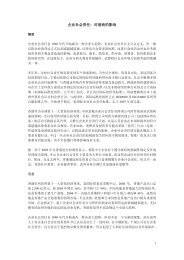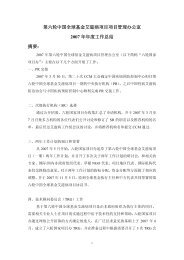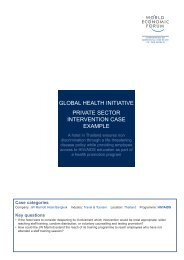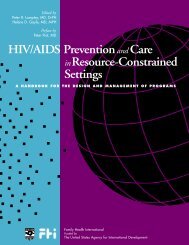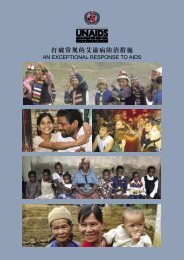What is HIV and AIDS?
What is HIV and AIDS?
What is HIV and AIDS?
Create successful ePaper yourself
Turn your PDF publications into a flip-book with our unique Google optimized e-Paper software.
Monitoring <strong>and</strong> evaluation (M&E) <strong>is</strong> essential in mainstreaming work. M&E must look<br />
at whether change has happened asking the following questions:<br />
Have changes occurred?<br />
<strong>What</strong> has changed?<br />
How has it changed?<br />
Why has it changed?<br />
Who was involved?<br />
When did it happen?<br />
These are basic starting points.<br />
Section 10: Monitoring <strong>and</strong> Evaluation<br />
M&E of mainstreaming work can be difficult to capture because you are looking at<br />
changes in attitudes <strong>and</strong> behaviours as well. Be aware of your context when<br />
designing monitoring <strong>and</strong> evaluation tools, making sure they are culturally<br />
appropriate.<br />
You may decide that before embarking on any activities to do a knowledge, attitude,<br />
behaviour <strong>and</strong> practice (KABP) survey. Th<strong>is</strong> can serve as baseline data. You can then<br />
measure after one year <strong>and</strong> two years what changes have taken place since then by<br />
repeating the survey. People may find it uncomfortable to write down let alone talk<br />
about personal practices <strong>and</strong> behaviour. You may w<strong>is</strong>h to start off with some<br />
questions regarding knowledge <strong>and</strong> attitudes first <strong>and</strong> then move onto behaviour. See<br />
Annex 19 for an example.<br />
For every activity that you do, you must incorporate some kind of monitoring. Th<strong>is</strong> <strong>is</strong><br />
important for two reasons; firstly to determine what people have learnt as a result of<br />
the activity <strong>and</strong> the second <strong>is</strong> what has worked well <strong>and</strong> any suggestions for<br />
improvements for next time. See Annex 20 for an example.<br />
It does not always have be formal written questionnaires but some way to capture<br />
what has happened. Be creative. Use the VSO guide “Participatory Approaches: A<br />
facilitator’s Guide” to help you design your monitoring activity. Remember, informal<br />
conversations <strong>and</strong> observations are just as important as quantitative data. For<br />
example, <strong>is</strong> there more d<strong>is</strong>cussion regarding <strong>HIV</strong> <strong>and</strong> <strong>AIDS</strong> amongst people? Are<br />
people using the free condoms available in the workplace? How have peoples<br />
relationships changed? Are men <strong>and</strong> women working together?<br />
For volunteers – as part of monitoring of your placements such as the quarterly or 6<br />
month review, questions regarding <strong>HIV</strong> mainstreaming are included to help VSO<br />
China capture changes that are happening at placement level.<br />
106




